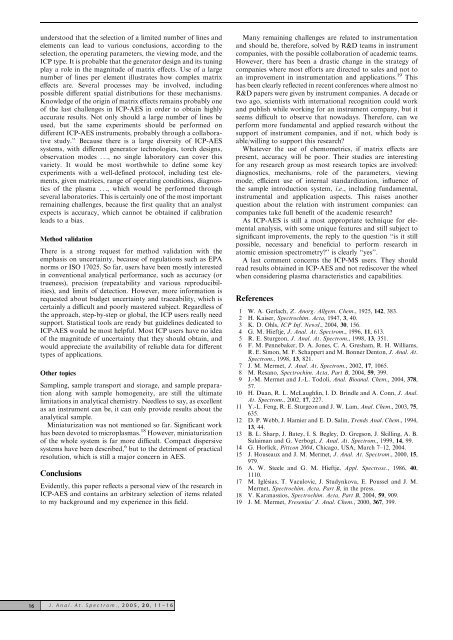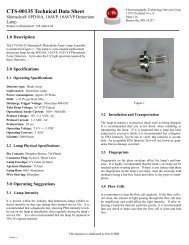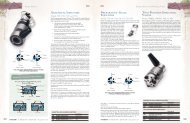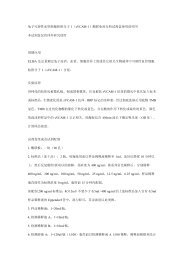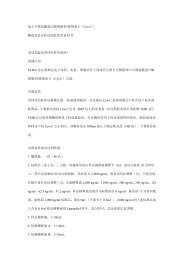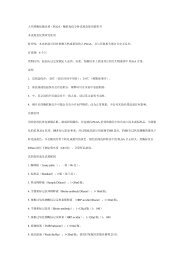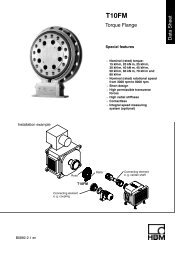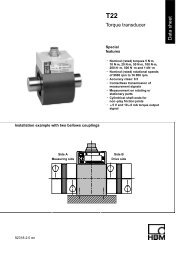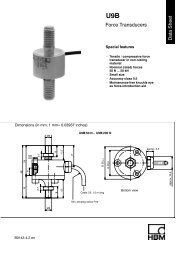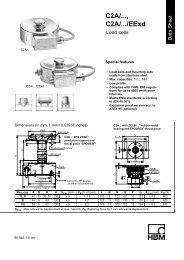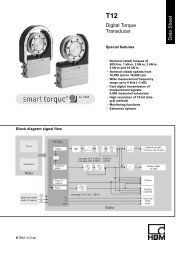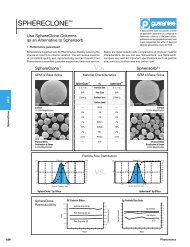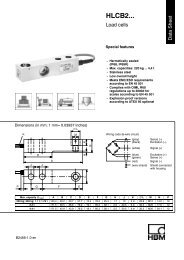Is it still possible, necessary and beneficial to perform research in ...
Is it still possible, necessary and beneficial to perform research in ...
Is it still possible, necessary and beneficial to perform research in ...
Create successful ePaper yourself
Turn your PDF publications into a flip-book with our unique Google optimized e-Paper software.
unders<strong>to</strong>od that the selection of a lim<strong>it</strong>ed number of l<strong>in</strong>es <strong>and</strong><br />
elements can lead <strong>to</strong> various conclusions, accord<strong>in</strong>g <strong>to</strong> the<br />
selection, the operat<strong>in</strong>g parameters, the view<strong>in</strong>g mode, <strong>and</strong> the<br />
ICP type. It is probable that the genera<strong>to</strong>r design <strong>and</strong> <strong>it</strong>s tun<strong>in</strong>g<br />
play a role <strong>in</strong> the magn<strong>it</strong>ude of matrix effects. Use of a large<br />
number of l<strong>in</strong>es per element illustrates how complex matrix<br />
effects are. Several processes may be <strong>in</strong>volved, <strong>in</strong>clud<strong>in</strong>g<br />
<strong>possible</strong> different spatial distributions for these mechanisms.<br />
Knowledge of the orig<strong>in</strong> of matrix effects rema<strong>in</strong>s probably one<br />
of the last challenges <strong>in</strong> ICP-AES <strong>in</strong> order <strong>to</strong> obta<strong>in</strong> highly<br />
accurate results. Not only should a large number of l<strong>in</strong>es be<br />
used, but the same experiments should be <strong>perform</strong>ed on<br />
different ICP-AES <strong>in</strong>struments, probably through a collaborative<br />
study.’’ Because there is a large divers<strong>it</strong>y of ICP-AES<br />
systems, w<strong>it</strong>h different genera<strong>to</strong>r technologies, <strong>to</strong>rch designs,<br />
observation modes ..., no s<strong>in</strong>gle labora<strong>to</strong>ry can cover this<br />
variety. It would be most worthwhile <strong>to</strong> def<strong>in</strong>e some key<br />
experiments w<strong>it</strong>h a well-def<strong>in</strong>ed pro<strong>to</strong>col, <strong>in</strong>clud<strong>in</strong>g test elements,<br />
given matrices, range of operat<strong>in</strong>g cond<strong>it</strong>ions, diagnostics<br />
of the plasma ..., which would be <strong>perform</strong>ed through<br />
several labora<strong>to</strong>ries. This is certa<strong>in</strong>ly one of the most important<br />
rema<strong>in</strong><strong>in</strong>g challenges, because the first qual<strong>it</strong>y that an analyst<br />
expects is accuracy, which cannot be obta<strong>in</strong>ed if calibration<br />
leads <strong>to</strong> a bias.<br />
Method validation<br />
There is a strong request for method validation w<strong>it</strong>h the<br />
emphasis on uncerta<strong>in</strong>ty, because of regulations such as EPA<br />
norms or ISO 17025. So far, users have been mostly <strong>in</strong>terested<br />
<strong>in</strong> conventional analytical <strong>perform</strong>ance, such as accuracy (or<br />
trueness), precision (repeatabil<strong>it</strong>y <strong>and</strong> various reproducibil<strong>it</strong>ies),<br />
<strong>and</strong> lim<strong>it</strong>s of detection. However, more <strong>in</strong>formation is<br />
requested about budget uncerta<strong>in</strong>ty <strong>and</strong> traceabil<strong>it</strong>y, which is<br />
certa<strong>in</strong>ly a difficult <strong>and</strong> poorly mastered subject. Regardless of<br />
the approach, step-by-step or global, the ICP users really need<br />
support. Statistical <strong>to</strong>ols are ready but guidel<strong>in</strong>es dedicated <strong>to</strong><br />
ICP-AES would be most helpful. Most ICP users have no idea<br />
of the magn<strong>it</strong>ude of uncerta<strong>in</strong>ty that they should obta<strong>in</strong>, <strong>and</strong><br />
would appreciate the availabil<strong>it</strong>y of reliable data for different<br />
types of applications.<br />
Other <strong>to</strong>pics<br />
Sampl<strong>in</strong>g, sample transport <strong>and</strong> s<strong>to</strong>rage, <strong>and</strong> sample preparation<br />
along w<strong>it</strong>h sample homogene<strong>it</strong>y, are <strong>still</strong> the ultimate<br />
lim<strong>it</strong>ations <strong>in</strong> analytical chemistry. Needless <strong>to</strong> say, as excellent<br />
as an <strong>in</strong>strument can be, <strong>it</strong> can only provide results about the<br />
analytical sample.<br />
M<strong>in</strong>iaturization was not mentioned so far. Significant work<br />
has been devoted <strong>to</strong> microplasmas. 18 However, m<strong>in</strong>iaturization<br />
of the whole system is far more difficult. Compact dispersive<br />
systems have been described, 6 but <strong>to</strong> the detriment of practical<br />
resolution, which is <strong>still</strong> a major concern <strong>in</strong> AES.<br />
Conclusions<br />
Evidently, this paper reflects a personal view of the <strong>research</strong> <strong>in</strong><br />
ICP-AES <strong>and</strong> conta<strong>in</strong>s an arb<strong>it</strong>rary selection of <strong>it</strong>ems related<br />
<strong>to</strong> my background <strong>and</strong> my experience <strong>in</strong> this field.<br />
Many rema<strong>in</strong><strong>in</strong>g challenges are related <strong>to</strong> <strong>in</strong>strumentation<br />
<strong>and</strong> should be, therefore, solved by R&D teams <strong>in</strong> <strong>in</strong>strument<br />
companies, w<strong>it</strong>h the <strong>possible</strong> collaboration of academic teams.<br />
However, there has been a drastic change <strong>in</strong> the strategy of<br />
companies where most efforts are directed <strong>to</strong> sales <strong>and</strong> not <strong>to</strong><br />
an improvement <strong>in</strong> <strong>in</strong>strumentation <strong>and</strong> applications. 19 This<br />
has been clearly reflected <strong>in</strong> recent conferences where almost no<br />
R&D papers were given by <strong>in</strong>strument companies. A decade or<br />
two ago, scientists w<strong>it</strong>h <strong>in</strong>ternational recogn<strong>it</strong>ion could work<br />
<strong>and</strong> publish while work<strong>in</strong>g for an <strong>in</strong>strument company, but <strong>it</strong><br />
seems difficult <strong>to</strong> observe that nowadays. Therefore, can we<br />
<strong>perform</strong> more fundamental <strong>and</strong> applied <strong>research</strong> w<strong>it</strong>hout the<br />
support of <strong>in</strong>strument companies, <strong>and</strong> if not, which body is<br />
able/will<strong>in</strong>g <strong>to</strong> support this <strong>research</strong>?<br />
Whatever the use of chemometrics, if matrix effects are<br />
present, accuracy will be poor. Their studies are <strong>in</strong>terest<strong>in</strong>g<br />
for any <strong>research</strong> group as most <strong>research</strong> <strong>to</strong>pics are <strong>in</strong>volved:<br />
diagnostics, mechanisms, role of the parameters, view<strong>in</strong>g<br />
mode, efficient use of <strong>in</strong>ternal st<strong>and</strong>ardization, <strong>in</strong>fluence of<br />
the sample <strong>in</strong>troduction system, i.e., <strong>in</strong>clud<strong>in</strong>g fundamental,<br />
<strong>in</strong>strumental <strong>and</strong> application aspects. This raises another<br />
question about the relation w<strong>it</strong>h <strong>in</strong>strument companies: can<br />
companies take full benef<strong>it</strong> of the academic <strong>research</strong>?<br />
As ICP-AES is <strong>still</strong> a most appropriate technique for elemental<br />
analysis, w<strong>it</strong>h some unique features <strong>and</strong> <strong>still</strong> subject <strong>to</strong><br />
significant improvements, the reply <strong>to</strong> the question ‘‘is <strong>it</strong> <strong>still</strong><br />
<strong>possible</strong>, <strong>necessary</strong> <strong>and</strong> <strong>beneficial</strong> <strong>to</strong> <strong>perform</strong> <strong>research</strong> <strong>in</strong><br />
a<strong>to</strong>mic emission spectrometry?’’ is clearly ‘‘yes’’.<br />
A last comment concerns the ICP-MS users. They should<br />
read results obta<strong>in</strong>ed <strong>in</strong> ICP-AES <strong>and</strong> not rediscover the wheel<br />
when consider<strong>in</strong>g plasma characteristics <strong>and</strong> capabil<strong>it</strong>ies.<br />
References<br />
1 W. A. Gerlach, Z. Anorg. Allgem. Chem., 1925, 142, 383.<br />
2 H. Kaiser, Spectrochim. Acta, 1947, 3, 40.<br />
3 K. D. Ohls, ICP Inf. Newsl., 2004, 30, 156.<br />
4 G. M. Hieftje, J. Anal. At. Spectrom., 1996, 11, 613.<br />
5 R. E. Sturgeon, J. Anal. At. Spectrom., 1998, 13, 351.<br />
6 F. M. Pennebaker, D. A. Jones, C. A. Gresham, R. H. Williams,<br />
R. E. Simon, M. F. Schappert <strong>and</strong> M. Bonner Den<strong>to</strong>n, J. Anal. At.<br />
Spectrom., 1998, 13, 821.<br />
7 J. M. Mermet, J. Anal. At. Spectrom., 2002, 17, 1065.<br />
8 M. Resano, Spectrochim. Acta, Part B, 2004, 59, 399.<br />
9 J.-M. Mermet <strong>and</strong> J.-L. Todolí, Anal. Bioanal. Chem., 2004, 378,<br />
57.<br />
10 H. Duan, R. L. McLaughl<strong>in</strong>, I. D. Br<strong>in</strong>dle <strong>and</strong> A. Conn, J. Anal.<br />
At. Spectrom., 2002, 17, 227.<br />
11 Y.-L. Feng, R. E. Sturgeon <strong>and</strong> J. W. Lam, Anal. Chem., 2003, 75,<br />
635.<br />
12 D. P. Webb, J. Hamier <strong>and</strong> E. D. Sal<strong>in</strong>, Trends Anal. Chem., 1994,<br />
13, 44.<br />
13 B. L. Sharp, J. Batey, I. S. Begley, D. Gregson, J. Skill<strong>in</strong>g, A. B.<br />
Sulaiman <strong>and</strong> G. Verbogt, J. Anal. At. Spectrom., 1999, 14, 99.<br />
14 G. Horlick, P<strong>it</strong>tcon 2004, Chicago, USA, March 7–12, 2004.<br />
15 J. Houseaux <strong>and</strong> J. M. Mermet, J. Anal. At. Spectrom., 2000, 15,<br />
979.<br />
16 A. W. Steele <strong>and</strong> G. M. Hieftje, Appl. Spectrosc., 1986, 40,<br />
1110.<br />
17 M. Iglésias, T. Vaculovic, J. Studynkova, E. Poussel <strong>and</strong> J. M.<br />
Mermet, Spectrochim. Acta, Part B, <strong>in</strong> the press.<br />
18 V. Karanassios, Spectrochim. Acta, Part B, 2004, 59, 909.<br />
19 J. M. Mermet, Fresenius’ J. Anal. Chem., 2000, 367, 399.<br />
16 J. Anal. At. Spectrom., 2005, 20, 11–16


